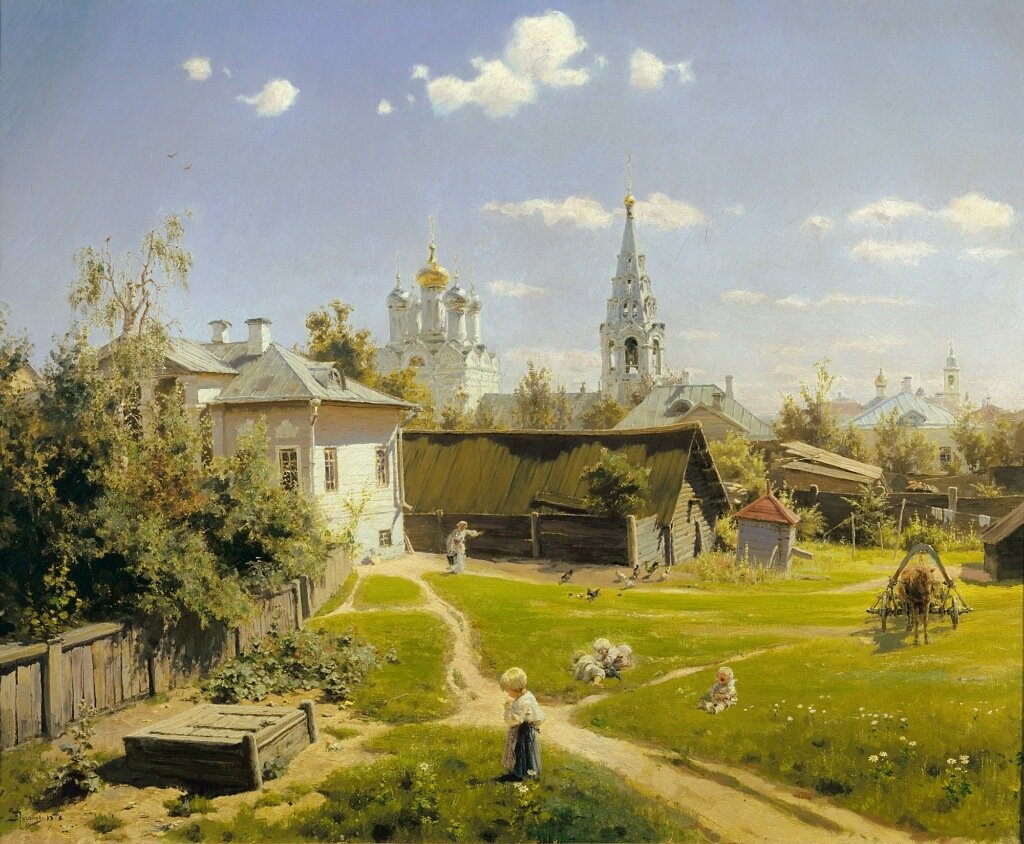V. Dubossarsky, A. Vinogradov
Moscow courtyard
2007
The one who depicted the typical image of the 19th century Moscow as well as the lives of the people in their daily pursuits was Vasly Polenov. His best-known painting "A Moscow Courtyard" (1877, State Tretyakov Gallery) shows some patio not far from Arbat street. The subject was chosen right. In their memoirs many 19th- and 20th-century writers, poets, artists and public figures who lived in pre-revolutionary Moscow returned time and time again to its magical courtyards with their special sounds and smells, which so captured the childish imagination. "A Moscow Courtyard" shows a multi-dimensional world, which accommodates equally well an old manor estate with a shady neglected garden, a church and abandoned lopsided barns. Children are playing in the yard, and a baby is crying. The mother is carrying a pail of water from the house - possibly to a horse which is hitched to a cart on the other side of the yard. More details such as chickens, a clothesline, and a covered well are in the foreground. And in the background are the spires, cupolas, and a bell towers of churches.
V. Polenov
A Moscow courtyard
1877
Later, the artist would reminisce: “I was looking for a flat, when I saw a notice on the door. I popped in to look, and immediately saw this view from the window. I sat down and painted it there and then.” In the list of Polenov’s works compiled by the artist himself, this painting (no. 123) is entitled “A Spot Near the Arbat”. This charming spot portrayed by Polenov still exists in nowadays Moscow though the neighbourhood has altered very much since then. The grassy ground is known by the name of Spasopeskovskaya ploshchadka (square). It is situated not far from Arbat street. A short Spasopeskovsky pereulok (lane) that takes off Arbat leads to the square.'Spasopeskovskaya' means "Saviour on the Sands," referring to the sandy soil of the neighborhood, which was first settled in the seventeenth century. The centre of this place is the beautiful Saviour Transfiguration church "on the sands", the Spasa Preobrazhenia na Peskakh, that gave the name to the site. Built around 1711, with railings dating from 1849, this five-domed church was a typical example of mid-17th – early 18thcentury architecture.
Constructed without the use of internal columns, it included a refectory, chapel of St. Nicholas and tall, hipped bell-tower, and was decorated with ornamental shells, nalichniki window frames and kokoshniki arches. The includes an additional church with bell-tower on the right – that of St. Nicholas the Miracle-Worker in Nikolsky Pereulok, now Plotnikov Pereulok. A further church in the Prechistenka area is discernible in the distance.
With well-chosen subject, excellent composition and successful use of colour and light Polenov created a coherent and powerful image of historical Moscow.
April 2011
Other children there
1947






Комментариев нет:
Отправить комментарий